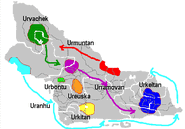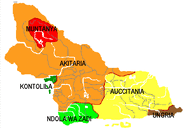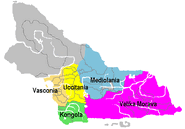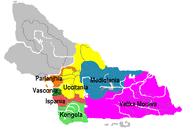Akitania Berria has a long and complex history. Despite being long inhabited by neolithical peoples, the earliest statelets in Princi Negre Island date from roughly 1690-1680BP. At that time, according to modern research, eight different cultures were already organized as states with an established government and culture: Urvachek, Uranhu, Urramovan, Urbontu, Ureuska, Urmuntan, Urkeltan and Urkitan. Each of these cultures is related to one ethnic group from Eras or Longerath. A series of major migrations over land and sea ensued for the next three centuries, until the establishment of the First Kingdoms, circa 1290BP: Muntanya, Ainhugo, Kaboua, Ramova Satara, Ramova Obnovena, Ainhi, Auniu, Agitenia, Monomatupo, Ntotila and Anhuko. A new migration wave from overseas brought the Ugere peoples.
By 794BP, the whole island was already claimed by the Twelve Kingdoms: Ipara, Bi Ugeria, Muntanya, Anhuko, Kontotila, Ndola, Akitenia, Podaria, Ramova Velika, Ainhugo, Ainhi and Ugry.
At roughly 400BP, King Jomo Kduli, from Ndola, creates the currently-used Akitania Berria Era calendar. At circa 150BP, Velika Morava established a colony in Northern Melania, on the present-day Mudyar Homeland of San Patricio.
From 200BP to 90BP, a series of wars resulted in the island being divided in two empires: Akitaria and Auccitania, together with the minor dominions of Ndola, Ungria, Muntanya and Kontolila. The year 73 saw the beginning of the long 250 Years War, when Ndola, Kontolila and Muntanya invaded Akitaria, while the Velika Morava revolt resulted in the destruction of Ungria in 62BP and the weakening of Auccitania.
By 60BP, Velika Morava was controlling the southeastern corner of Princi Negre. Ndola and Kontolila renamed themselves Kongola and Akitala and divided the old Akitaria empire with Muntanya. The remnants of the Akitarian and Auccitanian nobilities survived as the new kingdom of Aukitania, while the new state of Mediolania was established as well.
The Plague struck hard in Princi Negre island, effectively destroying the northern states and creating a wave of refugees. Muntanya and Akitala simply colapsed. The northernmost lands would continue to be held by minor princedoms and tribal states, with no centralized government, well into the 2nd century AP.
By 28AP, the eastern kingdoms of Velika Morava and Mediolania managed to expand at the cost of unstable Aukitania (now also known as Uccitania) and Kongola, which was further weakened by the revolts of Vasconia. The year 51 saw the Ispania and Parlanjhia rebellions against Vasconia, while Uccitania expanded at the cost of Mediolania.
On the year 74, Mediolania was further weakened by the Arpitanian revolt. Facing Arpitanian pressure, Uccitania grants independence to Berria and joins Arpitania on their war against Mediolania. By 94, Ispania and Parlanjhia form a coalition and attack Uccitania and Arpitania. Arpitania first resists but then becomes an ally and conquer a sector of Uccitania.
On 105AP, Parlanjhia, Uccitania and Kongola create the Great Triple Alliance for defense against their neighbours. On the year 109, Parlanjhia gives back occupied Uccitanian territories to Uccitania and gives Uccitania free hand to invade the remaining Berria. In 114, Parlanjhia conquers most of Arpitania, while two years later Uccitania and Kongola attack Ispania and set it back to its old boundaries.
On 130, Kongola and Mediolania set a massive attack against Velika Morava while, on 136, Berria re-emerges as an independent state, under the cover of which Uccitania sets terrorist attacks against the Parlanjhian empire. Parlanjhia finally fell on 141, under an alliance of Uccitania, Mediolania and Berria. A series of short wars occured on the next few decades. Uccitania won a short war against Arpitania on 155AP, while Velika Morava attacked Mediolania and got the upper hand on its conflict agains Kongola. On 165, tiny Berria attacked Arpitania.
The so-called Final War began in 172, as Berria attacks Uccitania and Parlanjhia, and loses. In the south, the conflict continues between between Kongola, Velika Morava and Mediolania. In 174, Vasconia and Ispania call for peace. Parlanjhia proclaims its neutrality. Berria resists further attacks from Uccitania and Arpitania. On 176, Mediolania proclaims its neutrality and withdraws from the Southern war.
Finally, after 249 years of nearly-continuous warfare between the various states, a general truce is signed. An assembly made of five representatives from each state is elected to implement the peace process. On the year 180, the assembly proclaimed its sovereignty over the entire island, forming the basis for the modern federation. The first constitution was signed in 182, while the capital city of Ciutat was established in 186.
The Free Territories were established in 187, while the Wildlife Territories were founded in 272.
| |||
|---|---|---|---|
| • Government • History • Geography • Economy • Military • (Tech Talk) • | |||
| Components: Congola • Greater Moravia • Arpitania • Berria • Ispania • Mediolania • Uccitania • Parlanjhia • Vaskonia • Federal Territories | |||
| Main Cities: Ciutat • Agusta • Engolesme • Sautama • Borja • (See all) | |||
| Culture: Symbols • Languages • Religion • Music • Sports • Culture Test |













